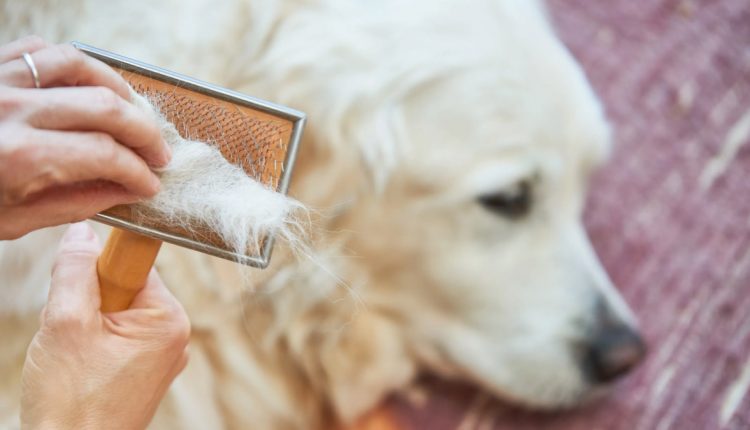Understanding Hair Loss in Dogs
Understanding Hair Loss in Dogs: Causes, Symptoms, and Management
As a pet owner, it’s not uncommon to notice your furry companion shedding some hair. However, excessive hair loss in dogs can be a cause for concern and may indicate an underlying health issue. In this article, we will explore the various causes of hair loss in dogs, common symptoms to watch out for, and how to manage and address this issue effectively.
Causes of Hair Loss in Dogs
Hair loss, or alopecia, in dogs can result from a variety of factors, including:
1. Allergies: Allergies to certain foods, pollen, dust mites, or other environmental factors can lead to itching and scratching, causing hair loss.
2. Parasites: Fleas, ticks, mites, and other parasites can irritate a dog’s skin, leading to hair loss, redness, and itching.
3. Infections: Bacterial or fungal skin infections can cause hair loss in localized areas.
4. Hormonal Imbalances: Hormonal imbalances, such as hypothyroidism or Cushing’s disease, can affect a dog’s coat and result in hair loss.
5. Stress or Anxiety: Dogs can experience stress or anxiety, leading to excessive grooming and hair loss, especially in specific patches.
6. Nutritional Deficiencies: Poor diet and nutrient deficiencies can result in a dull coat and hair loss.
7. Breed Predisposition: Some dog breeds are more prone to certain skin conditions and hair loss. For example, the Chinese Crested is known for its hairless or powderpuff appearance.
Symptoms of Hair Loss in Dogs
Identifying hair loss in dogs can be relatively straightforward if you know what to look for. Common symptoms include:
1. Bald Patches: Noticeable areas on your dog’s body where hair is missing.
2. Itching and Scratching: Dogs may excessively scratch or bite at their skin, often leading to hair loss.
3. Redness or Inflammation: Irritated or inflamed skin can accompany hair loss, especially in cases of allergies or infections.
4. Changes in Coat Texture: A dog’s coat may appear dull, dry, or flaky.
5. Behavioral Changes: Anxiety or stress-induced hair loss may be accompanied by changes in your dog’s behavior, such as restlessness or excessive licking.
Management and Treatment
Managing and treating hair loss in dogs involves identifying the underlying cause and then implementing the appropriate strategies to address the issue. Here are the steps involved in managing and treating hair loss in dogs:
- Consult a Veterinarian: The first and most crucial step is to consult a veterinarian. A veterinarian will perform a thorough physical examination, ask about your dog’s medical history, and may run diagnostic tests to determine the cause of the hair loss.
- Address Underlying Health Issues: Depending on the diagnosis, the veterinarian will recommend treatment. This may involve medication for infections, hormonal imbalances, or other medical conditions. Follow the prescribed treatment plan carefully.
- Parasite Control: If external parasites like fleas, ticks, or mites are causing the hair loss, the veterinarian will recommend appropriate parasite control measures. This may include topical treatments, oral medications, or collars.
- Allergy Management: If allergies are the cause of hair loss, the vet may recommend allergy testing to identify specific allergens. Management can include dietary changes, allergen avoidance, or allergy medications.
- Dietary Adjustments: Nutritional deficiencies can lead to poor coat health and hair loss. Ensure your dog is receiving a well-balanced diet that meets their nutritional needs. In some cases, your vet may recommend supplements or a special diet.
- Skin Care and Grooming: Regular grooming can help maintain a healthy coat and skin. Brush your dog to remove loose hair and distribute natural oils. Bathing with a gentle, hypoallergenic shampoo can help soothe the skin. Avoid over-bathing, as it can dry out the skin.
- Stress Reduction: Stress or anxiety can contribute to hair loss in dogs. Identify and address any sources of stress, and consider behavioral training or anxiety management techniques.
- Medicated Shampoos or Topical Treatments: In some cases, the vet may recommend medicated shampoos or topical treatments to manage skin conditions. Follow the vet’s instructions for the use of these products.
- Preserve a Calm Environment: Keep your dog in a calm and clean environment. Minimize exposure to environmental irritants, and provide a comfortable and stress-free living space.
- Skin Protection: Use protective clothing or barriers if your dog’s hair loss is due to environmental factors like sunburn. Sunscreen for dogs and protective clothing can help prevent further damage.
- Regular Follow-Up Visits: Keep regular follow-up appointments with your veterinarian to monitor your dog’s progress and adjust the treatment plan if necessary.
- Behavioral Observation: Keep an eye on your dog’s behavior. If excessive licking, scratching, or biting persists, consult your vet for further evaluation.
Final Conclusion about hair loss in dogs
Hair loss in dogs is a common issue with multiple potential causes, and identifying the underlying problem is crucial for effective treatment. Regular vet visits, a well-balanced diet, proper grooming, and a loving, stress-free environment can all contribute to maintaining your dog’s healthy coat. If you notice excessive hair loss or any concerning symptoms, consult your veterinarian for guidance and a tailored treatment plan to address your furry friend’s needs and ensure their comfort and well-being.

